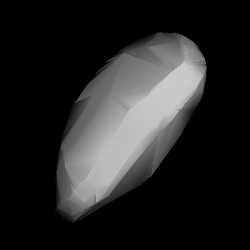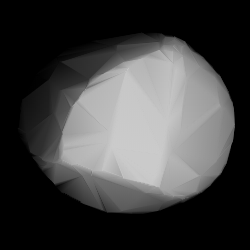
1983 Bok is a dark background asteroid from the central region of the asteroid belt. It was discovered on 9 June 1975, by American astronomer Elizabeth Roemer at the Catalina Station of the UA's Steward Observatory in Tucson, Arizona, and named for Bart Bok and Priscilla Fairfield Bok. The carbonaceous C-type asteroid has a rotation period of 10.7 hours and measures approximately 15 kilometers in diameter.
2023 Asaph, provisional designation 1952 SA, is a dark asteroid from the outer regions of the asteroid belt, approximately 21 kilometers in diameter. It was discovered on 16 September 1952, by astronomers of the Indiana Asteroid Program at Goethe Link Observatory in Indiana, United States.
1931 Čapek, provisional designation 1969 QB, is a background asteroid from the central regions of the asteroid belt, approximately 7 kilometers in diameter. It was discovered on 22 August 1969, by Czech astronomer Luboš Kohoutek at the Bergedorf Observatory in Hamburg, Germany. The asteroid was named in memory of Czech writer Karel Čapek.
1543 Bourgeois, provisional designation 1941 SJ, is a stony asteroid from the central asteroid belt's background population, approximately 12 kilometers in diameter. It was discovered on 21 September 1941, by astronomer Eugène Delporte at the Royal Observatory of Belgium in Uccle. The asteroid was named after Belgian astronomer Paul Bourgeois.
1569 Evita, provisional designation 1948 PA, is a dark background asteroid from the outer regions of the asteroid belt, approximately 36 kilometers in diameter. It was discovered on 3 August 1948, by astronomer Miguel Itzigsohn at the La Plata Astronomical Observatory in Argentina. The asteroid was named after Eva Perón.
2016 Heinemann, provisional designation 1938 SE, is a carbonaceous Themistian asteroid from the outer regions of the asteroid belt, approximately 22 kilometers in diameter. It was discovered on 18 September 1938, by German astronomer Alfred Bohrmann at Heidelberg Observatory in southwest Germany, and later named after ARI-astronomer Karl Heinemann (1898–1970).
11949 Kagayayutaka, provisional designation 1993 SD2, is a stony background asteroid from the outer region of the asteroid belt, approximately 23 kilometers (14 miles) in diameter. It was discovered on 19 September 1993, by Japanese amateur astronomers Kin Endate and Kazuro Watanabe at Kitami Observatory in eastern Hokkaidō, Japan. The asteroid was named after Japanese artist Kagaya Yutaka.
17683 Kanagawa (provisional designation 1997 AR16) is a carbonaceous background asteroid from the outer region of the asteroid belt, approximately 22 kilometers (14 miles) in diameter. It was discovered on 10 January 1997, by Japanese astronomer Atsuo Asami at the Hadano Observatory, located 60 kilometers southwest of Tokyo, Japan. The asteroid was later named after the Japanese Kanagawa Prefecture.
7958 Leakey, provisional designation 1994 LE3, is a Hungaria asteroid and synchronous binary system from the inner regions of the asteroid belt, approximately 3 kilometers in diameter.

1904 Massevitch is a background asteroid from the central region of the asteroid belt. It was discovered on 9 May 1972, by the Russian astronomer Tamara Smirnova at the Crimean Astrophysical Observatory in Nauchnyj, on the Crimean peninsula. The uncommon R-type asteroid has a rotation period of 5.3 hours and measures approximately 16 kilometers in diameter. It was later named after Russian astrophysicist Alla Masevich.
3176 Paolicchi, provisional designation 1980 VR1, is a carbonaceous asteroid from the outer region of the asteroid belt, about 34 kilometers in diameter. It was discovered on 13 November 1980, by Serbian astronomer Zoran Knežević at the Konkoly Observatory's Piszkéstető Station northeast of Budapest, Hungary.
1646 Rosseland, provisional designation 1939 BG, is a stony asteroid from the inner regions of the asteroid belt, approximately 12 kilometers in diameter. It was discovered on 19 January 1939, by Finnish astronomer Yrjö Väisälä at Turku Observatory in Southwest Finland. It was later named after Norwegian astrophysicist Svein Rosseland.
1907 Rudneva, provisional designation 1972 RC2, is a stony background asteroid from the central regions of the asteroid belt, approximately 11 kilometers in diameter. It was discovered on 11 September 1972, by astronomer Nikolai Chernykh at the Crimean Astrophysical Observatory, Nauchnyj, on the Crimean peninsula. The asteroid was named after Soviet geodesist and war hero Yevgeniya Rudneva.
1405 Sibelius, provisional designation 1936 RE, is a stony Florian asteroid from the inner regions of the asteroid belt, approximately 8 kilometers in diameter. It was discovered on 12 September 1936, by Finnish astronomer Yrjö Väisälä at Turku Observatory in Southwest Finland. The asteroid was named after composer Jean Sibelius.
79912 Terrell (provisional designation 1999 CC3) is a dark Adeonian asteroid from the central regions of the asteroid belt, approximately 6 kilometers in diameter. It was discovered on 10 February 1999, by astronomers Walter Cooney and Ethan Kandler at the Highland Road Park Observatory, in Baton Rouge, Louisiana, United States. The asteroid was named after American astrophysicist Dirk Terrell.

1933 Tinchen, provisional designation 1972 AC, is a Vestian asteroid from the inner regions of the asteroid belt, about 5 kilometers in diameter. It was discovered on 14 January 1972, by Czech astronomer Luboš Kohoutek at the Hamburger Bergedorf Observatory in Germany, who named it after his wife, Christine Kohoutek.
1513 Mátra, provisional designation 1940 EB, is a stony Florian asteroid from the inner regions of the asteroid belt, approximately 5 kilometers in diameter. It was discovered on 10 March 1940, by Hungarian astronomer György Kulin at Konkoly Observatory in Budapest, Hungary. It was later named after the Mátra mountain range.
1856 Růžena, provisional designation 1969 TW1, is a stony asteroid from the inner regions of the asteroid belt, approximately 6.6 kilometers in diameter. It was discovered on 8 October 1969, by Russian astronomer Lyudmila Chernykh at Crimean Astrophysical Observatory in Nauchny, on the Crimean peninsula. The asteroid was named after Růžena Petrovicova, staff member at Kleť Observatory.
1478 Vihuri, provisional designation 1938 CF, is a stony asteroid from the inner regions of the asteroid belt, approximately 9 kilometers in diameter. It was discovered on 6 February 1938, by Finnish Yrjö Väisälä at Turku Observatory in Southwest Finland. The asteroid was named after a Finnish philanthropist by the name of A. Vihuri.
13025 Zürich, provisional designation 1989 BA, is a stony Phocaea asteroid from the inner regions of the asteroid belt, approximately 5 kilometers in diameter. It was discovered on 28 January 1989, by Swiss astronomer Paul Wild at Zimmerwald Observatory near Bern, Switzerland, and later named for the Swiss city of Zürich.



